
XXXI Simpósio Brasileiro de Telecomunicações
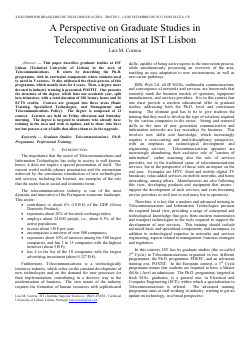
A Perspective on Graduate Studies in Telecommunications at IST Lisbon
Luis M. Correia
DOI: 10.14209/sbrt.2013.244
Keywords: Graduate Studies Telecommunications Ph.D. Programme Professional Training
Abstract
This paper describes graduate studies at IST Lisbon (Technical University of Lisbon) in the area of Telecommunications. It starts by describing the Ph.D. programme, with its curricular components where students need to enrol in 5 courses. It also addressed the thesis process of this programme, which usually lasts for 4 years. Then, a degree more devoted to industry training is presented, POSTIT. One presents the structure of the degree, which lasts one academic year, split into trimesters, with a total duration of 300 lecture hours and 36 ECTS credits. Courses are grouped into three areas (Basic Training, Specialised Technologies, and Management and Telecommunications Policy). The degree is composed of 12 courses. Lectures are held on Friday afternoon and Saturday morning. The degree is targeted to students who already have training in the area and wish to update, and to those who have not but possess a set of skills that allows them to do the upgrade.Download
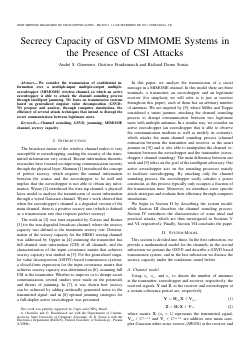
Secrecy Capacity of GSVD MIMOME Systems in the Presence of CSI Attacks
André S. Guerreiro, Gustavo Fraidenraich, Richard Demo Souza.
DOI: 10.14209/sbrt.2013.164
Keywords: Channel sounding GSVD jamming MIMOME channel secrecy capacity
Abstract
We consider the transmission of confidential in- formation over a multiple-input multiple-output multiple- eavesdropper (MIMOME) wireless channel, in which an active eavesdropper is able to attack the channel sounding process through intelligent jamming. We focus on transmission systems based on generalized singular value decomposition (GSVD). We propose and analyze, through computer simulations, the efficiency of several attack techniques that intend to disrupt the secret communication between legitimate users.Download
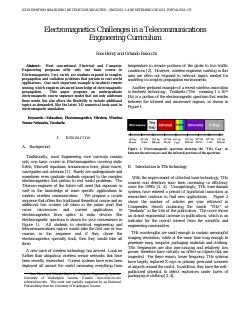
Electromagnetics Challenges in a Telecommunications Engineering Curriculum
Sam Henry, Orlando Baiocchi
DOI: 10.14209/sbrt.2013.165
Keywords: Education Electromagnetics Wireless Wireless Sensor Networks Terahertz.
Abstract
Most conventional Electrical and Computer Engineering programs offer only one basic course in Electromagnetics. Very rarely are students exposed to complex propagation and radiation problems that pertain to real world applications. One such important example is terahertz remote sensing, which requires advanced knowledge of electromagnetic propagation. This paper proposes an undergraduate electromagnetic course sequence model that not only addresses these needs, but also offers the flexibility to include additional topics as demanded, like the latest 3-D numerical tools used in electromagnetic simulation.Download
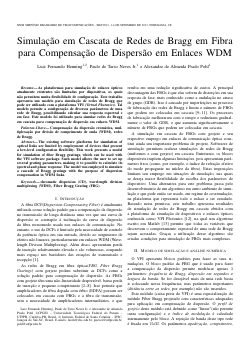
Simulação em Cascata de Redes de Bragg em Fibra para Compensação de Dispersão em Enlaces WDM
Luiz Fernando Henning, Paulo de Tarso Neves Jr., Alexandre de Almeida Prado Pohl
DOI: 10.14209/sbrt.2013.166
Keywords: Compensação da dispersão cromática mul- tiplexação por divisão de comprimento de onda (WDM) redes de Bragg.
Abstract
As plataformas para simulação de enlaces ópticos atualmente existentes são limitadas por dispositivos, os quais não permitem muita flexibilidade de configuração. Este trabalho apresenta um modelo para simulação de redes de Bragg que pode ser utilizado com a plataforma VPI (Virtual Photonics). Tal modelo permite a configuração de diversos parâmetros de uma rede de Bragg, possibilitando calcular sua resposta espectral e em fase. Este modelo foi utilizado para simular redes de Bragg em cascata para compensação de dispersão em enlaces WDM.Download
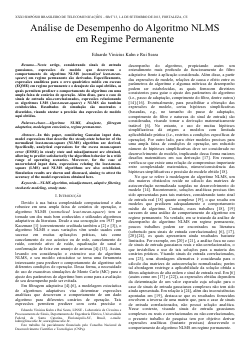
Análise de Desempenho do Algoritmo NLMS em Regime Permanente
Eduardo Vinicius Kuhn, Rui Seara
DOI: 10.14209/sbrt.2013.153
Keywords: Algoritmo NLMS desajuste filtragem adaptativa modelagem estocástica regime permanente.
Abstract
Neste artigo, considerando sinais de entrada gaussianos, expressões de modelo que descrevem o comportamento do algoritmo NLMS (normalized least-meansquare) em regime permanente são derivadas. Especificamente, expressões analíticas para o erro quadrático médio em excesso (EQME) em regime permanente e o desajuste são aqui obtidas, as quais permitem predizer o comportamento do algoritmo em uma ampla faixa de cenários de operação. Além disso, para o caso de sinais de entrada não-correlacionados, expressões relacionando os algoritmos LMS (least-mean-square) e NLMS são também estabelecidas. Resultados de simulação são mostrados e discutidos, visando atestar a precisão das expressões de modelo aqui obtidas.Download
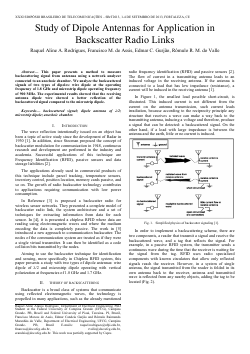
Study of Dipole Antennas for Application in Backscatter Radio Links
Raquel Aline A. Rodrigues, Francisco M. de Assis, Edmar C. Gurjão, Rômulo R. M. do Valle
DOI: 10.14209/sbrt.2013.154
Keywords: backscattered signal dipole antenna of λ/2 microstrip dipole anechoic chamber
Abstract
This paper presents a method to measure backscattering signal from antennas using a network analyzer connected to an anechoic chamber. We analyze the backscattered signals of two types of dipoles: wire dipole at the operating frequency of 1.8 GHz and microstrip dipole operating frequency of 900 MHz. The experimental results showed that the receiving antenna dipole wire showed a better reflection of the backscattered signal compared to the microstrip dipole.Download
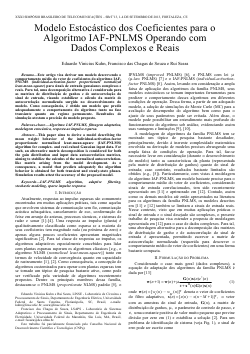
Modelo Estocástico dos Coeficientes para o Algoritmo IAF-PNLMS Operando com Dados Complexos e Reais
Eduardo Vinicius Kuhn, Francisco das Chagas de Souza, Rui Seara
DOI: 10.14209/sbrt.2013.167
Keywords: Algoritmo IAF-PNLMS filtragem adaptativa modelagem estocástica resposta ao impulso esparsa
Abstract
Este artigo visa derivar um modelo descrevendo o comportamento médio do vetor de coeficientes do algoritmo IAFPNLMS (individual-activation-factor proportionate normalized least-mean-square) para sinais de entrada gaussianos complexos e reais. Para tal, uma decomposição alternativa é considerada para as matrizes de distribuição de ganhos e de autocorrelação do sinal de entrada, visando estabilizar o cálculo da matriz de autocorrelação normalizada surgida no desenvolvimento do modelo. Como consequência, é obtido um modelo que prediz adequadamente o comportamento do algoritmo tanto na fase transiente quanto em regime permanente. Resultados de simulação atestam a precisão do modelo proposto.Download
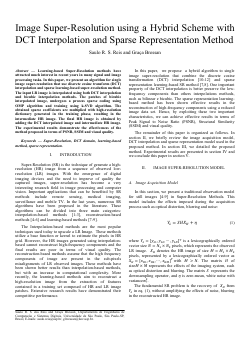
Image Super-Resolution using a Hybrid Scheme with DCT Interpolation and Sparse Representation Method
Saulo R. S. Reis, Graça Bressan
DOI: 10.14209/sbrt.2013.168
Keywords: Super-Resolution DCT domain learning-based method sparse representation .
Abstract
Learning-based Super-Resolution methods have attracted much interest in recent years in many signal and image processing tasks. In this paper, we present an algorithm for single image super-resolution that use discrete cosine transform (DCT) interpolation and sparse learning-based super-resolution method. The input LR image is interpolated using both DCT interpolation and bicubic interpolation methods. The patches of bicubic interpolated image, undergoes a process sparse coding using OMP algorithm and training using k-SVD algorithm. The obtained sparse coefficients are multiplied with high-resolution dictionary generated in the training phase, resulting in the intermediate HR image. The final HR image is obtained by adding the DCT interpolated image and intermediate HR image. The experimental results demonstrate the effectiveness of the method proposed in terms of PSNR, SSIM and visual qualityDownload
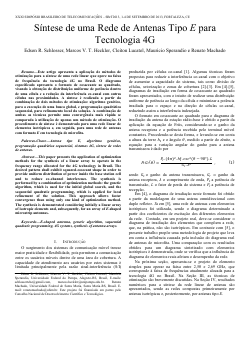
Síntese de uma Rede de Antenas Tipo E para Tecnologia 4G
Edson R. Schlosser, Marcos V. T. Heckler, Cleiton Lucatel, Mauricio Sperandio, Renato Machado
DOI: 10.14209/sbrt.2013.169
Keywords: Antena tipo E algoritmo genético programação quadrática sequencial sistemas 4G síntese de redes de antenas.
Abstract
Este artigo apresenta a aplicação de métodos de otimização para a síntese de uma rede linear que opere na faixa de frequência da tecnologia 4G no Brasil. O diagrama especificado apresenta o formato de cossecante ao quadrado, visando à obtenção de distribuição uniforme de potência dentro de uma célula e a redução da interferência co-canal com outras células nas proximidades. A síntese é realizada a partir da combinação de dois métodos de otimização: algoritmo genético, para a execução de uma busca global, e programação quadrática sequencial, para refinamento local da solução. A combinação de ambas as técnicas permite uma convergência mais rápida se comparada à utilização de apenas um método de otimização. O procedimento de síntese é demonstrado para uma rede linear de elementos isotrópicos e, em seguida, para uma rede de antenas com formato E em tecnologia de microfita.Download
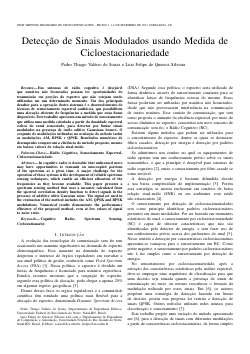
Detecção de Sinais Modulados usando Medida de Cicloestacionariedade
Pedro Thiago Valério de Souza, Luiz Felipe de Queiroz Silveira
DOI: 10.14209/sbrt.2013.26
Keywords: Cognitive Radio Spectrum Sensing Cyclostationarity
Abstract
In cognitive radio is desirable that unlicensed users may have opportunities to transmit on unoccupied portions of the spectrum at a given time. A major challenge for the operation of these systems is the development of reliable spectrum sensing techniques, which enable an efficient allocation of the frequencies as they become available. This paper presents a spectrum sensing method that uses a measure calculated from the spectral correlation density function to detect signals in the presence of additive white Gaussian noise. The signal set used in the evaluation of the method includes the AM, QPSK and BPSK modulations. Numerical results demonstrate the performance efficiency of the proposed method, even at low values of signal to noise ratio.Download